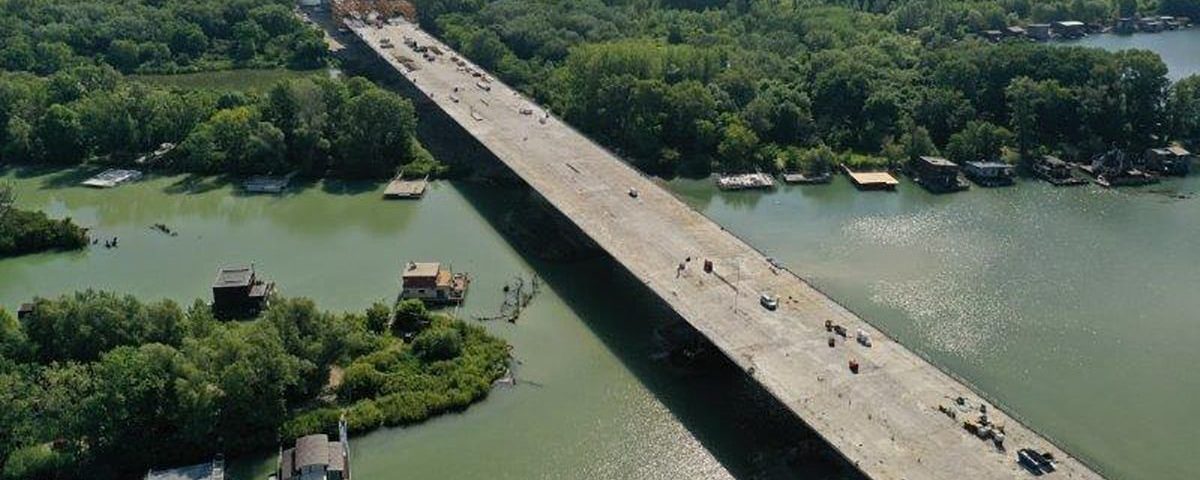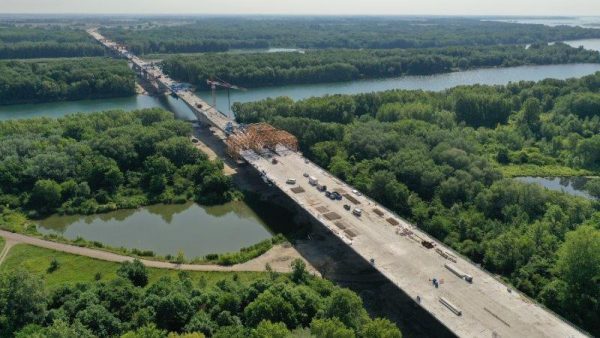
Bratislava is located more than 400 kilometers from the sea. And yet, the city is still connected to it. Despite being surrounded by mountains and forests, the city is home to the most important port in Slovakia. There, goods and passengers are sent east, connecting with the Black Sea and headed towards the North Sea. This journey is made on a highway of water that has connected Europe for millennia.
The Danube crossed the continent before the first humans settled in what is now Bratislava. The oldest traces of a stable human presence in the area date back to 5000 BC. Since then, the city’s history, development, and growth have run alongside the river.
Today, the historic waterway has teamed up with the forces of progress through a new bridge. Actually, it’s four bridges in one: a 3,000-meter bridge made of 110,000 cubic meters of concrete that rises over Europe’s most important river. This is the story of how the new D4/R7 motorway crossing over the Danube came to be.
One bridge for a continent
Bratislava is known for its mountains. It sits in one corner of its territory, right at the borders of neighboring countries. The Danube crosses through the city, acting as a border with Hungary, and its tributary, the Morava River, also forms the capital’s border with Austria. In fact, the point where the Morava and the Danube meet in Slovak territory is the site of the ruins of the Devín Castle, which has witnessed the history of Europe for centuries from quite the vantage point. The Czech Republic begins a little further to the north, a country that shares a common past with Slovakia.
The development and economy of Bratislava and the rest of the territory are closely linked to trade with the surrounding countries and other member states of the European Union. Trade means merchandise coming and going, and that, in turn, means traffic. The roads connecting Austria (Vienna), the Czech Republic (Brno), and Hungary (Budapest) with Slovakia largely converge in Bratislava. Every day, thousands of vehicles and trucks pass through parts of the capital. That’s where the new bridge comes in.
The viaduct is part of the D4/R7 highway project carried out by Ferrovial Construction. This new connecting route consists of two parts: a ring road to the east of Bratislava (D4) and a new arm to the southeast (R7). When it is finished in the next few months, this bridge will relieve light traffic by 15% and heavy traffic by 50% in the city.
A mobile scaffolding on the Danube
 Mobile scaffolding technology has allowed the precast concrete bridge to be built on-site.
Mobile scaffolding technology has allowed the precast concrete bridge to be built on-site.
The SNP, the Apollo, the Pristavny, the E65, the 68… The list of Bratislava’s bridges over the Danube River is long. But none of them are longer than the New Bridge over the Danube River, perhaps the most iconic infrastructure on the ring road and the new radial highway.
Its three kilometers stretch across four different viaducts: the crossing over Lake Jarovecké at 785 meters long; the bridge over the city’s kayak route at 470 meters long; the section over the Danube itself measuring 430 meters long, and the road over Lake Biskupické at 1250 meters long. Construction on all the sections was carried out in a similar way, except for the two viaducts over the lakes. These used one of the largest mobile scaffolding systems available on the market, technology that makes it possible to build precast concrete bridges on-site.
Construction on the four bridges was carried out in two phases. First, their cores were built (up to 16 meters wide and 13 meters high in the stretches over the kayak route and the Danube). Then, the wings were extended to cover the width of the platform, some 35 meters. In all, about 100,000 cubic meters of concrete and 4,000 tons of pre-stressed steel were used.
When it opens, the new bridge over the Danube will support up to 35,000 vehicles a day. It will reduce much of the heavy traffic in Slovakia’s capital and span into the area south of Bratislava – until now, this spot was exclusively for the river and its many branches.
Beyond the river
The sheer size of the bridge and its relationship to the iconic river are seizing the spotlight. Still, the D4/R7 motorway is even more than that. In addition to crossing over the Danube, the D4 ring road will include 57 more footbridges, and the radial R7 will add another 37. In total, both routes will add up to 59 kilometers meant to alleviate Bratislava’s heavy traffic and improve transportation time for traffic that doesn’t need to stop in the city.
Some sections of the new infrastructure, such as the stretch linking Ivanka Sever with Čierna Voda (two towns on the outskirts of Bratislava), will handle a high traffic volume of up to 45,000 vehicles per day. The drop in urban traffic will be immediate, but it is expected to reach its maximum over time. By 2060, heavy traffic will be 25% lower than it is today.
Less than 60 kilometers of asphalt can change life in a city. Alongside it, carrying the weight of history, the Danube will continue to run its course, a vital link in the nearly 3,000 kilometers that separate its sources in Germany’s Black Forest from its delta mouth on the coast of Romania. Bratislava will continue to stand watch on that road off the banks of Europe’s great highway of water.





There are no comments yet